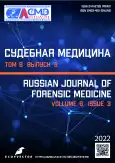Morphological signs of fatal acute general cold injury in the air
- Authors: Chudakov A.Y.1, Bozhchenko A.P.2, Khrustaleva Y.A.2, Tolmachev I.A.2
-
Affiliations:
- Saint Petersburg University of the Ministry of the Interior of the Russian Federation
- Kirov Military medical academy
- Issue: Vol 8, No 3 (2022)
- Pages: 47-55
- Section: Original study articles
- URL: https://bakhtiniada.ru/2411-8729/article/view/122466
- DOI: https://doi.org/10.17816/fm742
- ID: 122466
Cite item
Full Text
Abstract
BACKGROUND: Cold trauma is one of the leading causes of violent death in the Russian Federation due to the peculiarities of its geographical location. The pathophysiological processes occurring in the human body during hypothermia remain insufficiently studied despite a large number of studies, and quantitative characteristics of diagnostic signs most often used in expert practice are not precise.
AIMS: To clarify and supplement the complex characteristic and pathognomonic macro- and microscopic signs of fatal acute general cold injury
MATERIAL AND METHODS: Morphological signs of death from general hypothermia were analyzed based on the materials of forensic medical examinations concerning 460 corpses of people who died from hypothermia in the air using descriptive statistics, content-, and formal-logical methods.
RESULTS: The macro- and microscopic signs of cold injury have been clarified, supplemented, and systematized. A quantitative assessment of the frequency of occurrence (detectability) of diagnostically significant signs, most often used in expert practice, is given. The main signs of death from general hypothermia include ischemia of the “shell” in combination with fullness and edema of the “core” of the body, blood thickening with coagulations, micro- and macrothrombosis with hemorrhages into internal organs (brain, brain membranes, heart, lungs, kidneys, stomach, etc.), spasm (rigor mortis) of various muscle groups, and trophic and necrotic changes in internal organs.
CONCLUSION: The revealed signs of death from general acute deep hypothermia in the air expand the existing ideas about the complex characters and pathognomonic signs in this type of injury and allows reliable differential diagnosis of the cause of death during the forensic examination of a corpse.
Full Text
##article.viewOnOriginalSite##About the authors
Alexandr Y. Chudakov
Saint Petersburg University of the Ministry of the Interior of the Russian Federation
Email: chief.chudakow@yandex.ru
ORCID iD: 0000-0003-3443-7908
SPIN-code: 2822-8027
MD, Dr. Sci. (Med.), Professor
Russian Federation, Saint PetersburgAlexandr P. Bozhchenko
Kirov Military medical academy
Author for correspondence.
Email: bozhchenko@mail.ru
ORCID iD: 0000-0001-7841-0913
SPIN-code: 1110-0515
MD, Dr. Sci. (Med.), Associate Professor
Russian Federation, Saint PetersburgYulia A. Khrustaleva
Kirov Military medical academy
Email: khrustaleva-julia@yandex.ru
ORCID iD: 0000-0001-5282-7219
SPIN-code: 3622-5270
MD, Dr. Sci. (Med.), Associate Professor
Russian Federation, Saint PetersburgIgor A. Tolmachev
Kirov Military medical academy
Email: 5154324@mail.ru
ORCID iD: 0000-0002-5893-520X
SPIN-code: 5794-9030
MD, Dr. Sci. (Med.), Professor
Russian Federation, Saint PetersburgReferences
- Pigolkin YI, Solodovnikov VI, Kislov MA, Oganesyan NS. Comparative epidemiology of thermal injury and hypothermia. Sudebno-meditsinskaya ehkspertiza. 2021;64(2):4–9. (In Russ). doi: 10.17116/sudmed2021640214
- Shalaby SA, Fouad Y, Azab SM, et al. Predictors of mortality in cases of thermal burns admitted to Burn Unit, Ain Shams University Hospitals. J Forensic Leg Med. 2019;(67):19–23. doi: 10.1016/j.jflm.2019.07.011
- Bozhchenko AP, Isakov VD, Yagmurov OD, et al. Comparative analysis of the volume and structure of non-violent death in Saint Petersburg and Novgorod region over the past 5 years. Sudebno-meditsinskaya ekspertisa. 2022;65(3):10–14. (In Russ). doi: 10.17116/sudmed20226503110
- Bogomolova IN, Bogomolov DV, Perepelkin AV, et al. Microscopic differential diagnostic signs of fatal cold injury. Methodological recommendations. Moscow; 2014. (In Russ).
- Shigeev VB, Shigeev SV, Koludarova EM. Cold death. Moscow: Novosti; 2004. 184 р. (In Russ).
- Chudakov AY. Forensic and physiological characteristics of acute general deep accidental hypothermia [dissertation abstract]. Saint Petersburg; 1997. 23 р. (In Russ).
- Desyatov VP. Death from general hypothermia of the body [dissertation abstract]. Tomsk; 1969. 27 р. (In Russ).
- Rajskij MI. To the doctrine of the recognition of death from cold [dissertation abstract]. Tomsk; 1907. 27 р. (In Russ.)
- Puparev KV. Retracted testis upward to the abdominal ring, as a permanent sign and more than other signs characterizing death by freezing. Drug zdorov’ya. 1847;(43):339–340. (In Russ).
- Blonssfeld T. Die gerichtsarztliche Auffassung der Todesursachen besondere uber den Tod durch Erfrieren in Beziehungzu seinen Bedingungen und Ursachen. Z Staatsarzneikunde. 1860;40:143–174. (In German).
- Dieberg C. Hundert gerichtliche Sektionen. Tod durch Kalte. Vierteljahresschr Gerichtl Offetl Med. 1864;l:303–316. (In German).
- Puhnarevich VI. Some observations in the study of corpses of persons who died from cooling. Sudebno-meditsinskaya ekspertisa. 1960;(3):48–50. (In Russ).
- Vishnevsky SM. A new sign of death from freezing. Vestnik obshchej gigieny, sudebnoj i prakticheskoj mediciny. 1895;1:11–20. (In Russ).
- Nikol’sky II. Regarding the forensic significance of hemorrhage of the gastric mucosa in death from freezing. The Bulletin of Public Hygiene, Forensic and Practical Medicine. 1898;(2):1009–1013. (In Russ).
- Fabrikantov PA. To morphological signs of death from body cooling. Collection of scientific papers on forensic medicine and the border area. Moscow: Medgiz; 1955. 70 р. (In Russ).
- Osminkin VA. Pathomorphology of the lungs at death from hypothermia in the air [dissertation abstract]. Leningrad; 1988. 22 р. (In Russ).
- Smyslova AM. On the recognition of death by freezing: microscopic changes in the lungs under the action of low temperature. Saint Petersburg; 1909. 84 р. (In Russ).
- Kasyanov MI. Essays on forensic histology. Moscow: Medicina; 1954. 142 р. (In Russ).
Supplementary files







